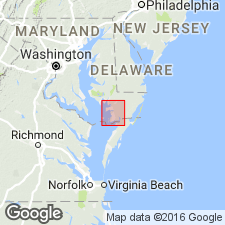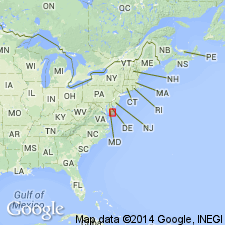
- Usage in publication:
-
- Parsonsburg sand*
- Modifications:
-
- Original reference
- Dominant lithology:
-
- Sand
- AAPG geologic province:
-
- Atlantic Coast basin
Summary:
Pg. 114 (table 17), 118-119. Parsonsburg sand. Composed predominantly of medium-grained sand but is poorly sorted. Materials range from size of small boulders (rare), through cobbles, gravel, very coarse to very fine sand, silt, and clay. In color, it is buff, tan, orange, or brown. Thickness in reference locality 25 feet; elsewhere ranges from a fraction of a foot to as much as 33 feet. In different places, rests unconformably on each of the earlier Pleistocene deposits. In reference locality, overlies the Walston silt (new). Overlain only by soils, alluvium, and peat of Recent series. Age is Pleistocene (late Wisconsin).
Reference locality: test hole Wi-Bg 11 at Melson, at north end of Parsonsburg Ridge [local name]; [Melson is about 0.75 mi south of MD-DE State line, Pittsville 7.5-min quadrangle, Wicomico Co., southeastern MD]. Named from Parsonsburg, a village 6 mi east of Salisbury, southeastern MD.
Source: US geologic names lexicon (USGS Bull. 1200, p. 2933).

- Usage in publication:
-
- Parsonsburg Sand*
- Modifications:
-
- Areal extent
- AAPG geologic province:
-
- Atlantic Coast basin
Summary:
Parsonsburg Sand. Geographically extended from southeastern Maryland into southern Delaware. Age is late Pleistocene (late Wisconsinan).
Source: Changes in stratigraphic nomenclature, 1964 (USGS Bull. 1502-A, p. A55).
For more information, please contact Nancy Stamm, Geologic Names Committee Secretary.
Asterisk (*) indicates published by U.S. Geological Survey authors.
"No current usage" (†) implies that a name has been abandoned or has fallen into disuse. Former usage and, if known, replacement name given in parentheses ( ).
Slash (/) indicates name conflicts with nomenclatural guidelines (CSN, 1933; ACSN, 1961, 1970; NACSN, 1983, 2005, 2021). May be explained within brackets ([ ]).

